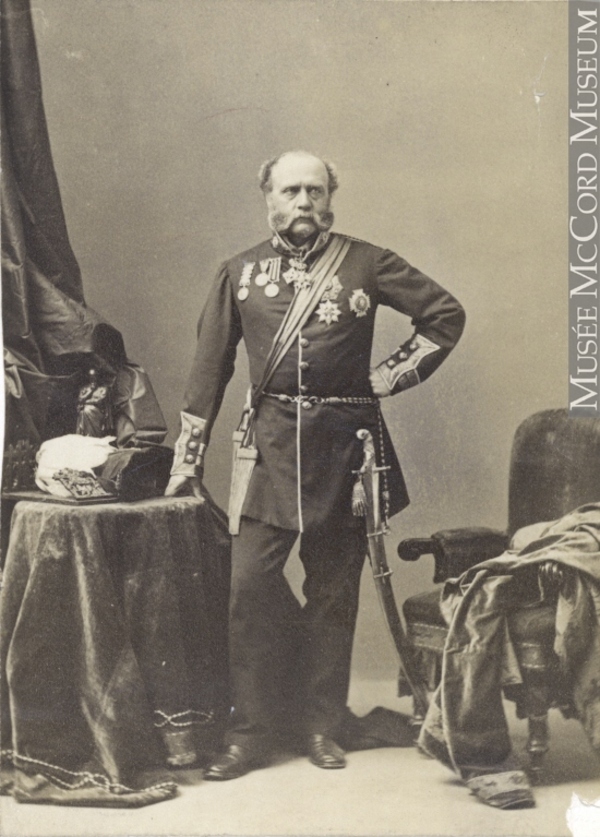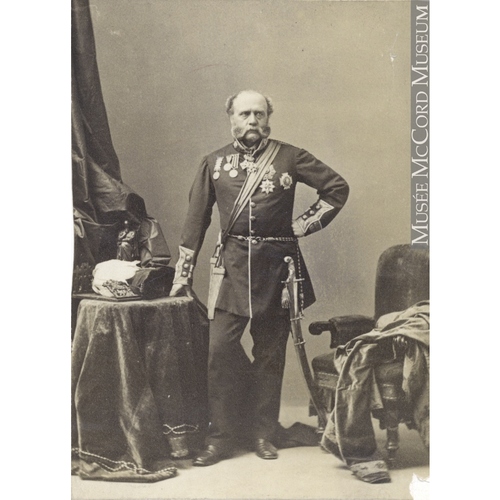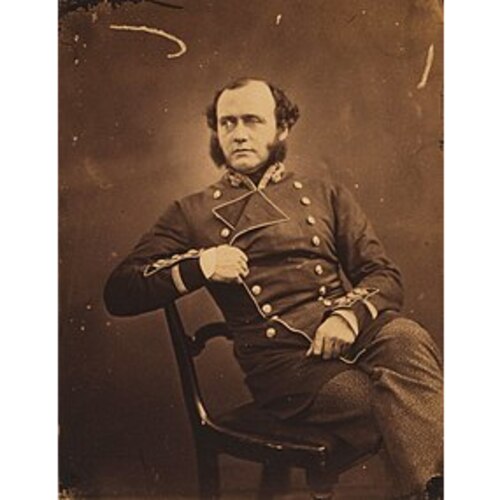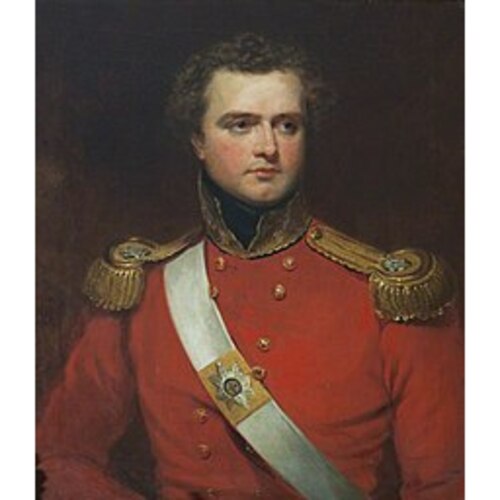
Source: Link
WINDHAM, Sir CHARLES ASH, soldier; b. 10 Oct. 1810 at Felbrigg, Norfolk, England, son of Vice-Admiral William Windham and Ann Thellusson; m. first in 1849 Marianne Catherine Emily Beresford, and they had five children, and secondly in 1866 Charlotte Jane Des Voeux; d. 2 Feb. 1870 at Jacksonville, Fla.
Charles Ash Windham was educated at the Royal Military College, Sandhurst, and commissioned in the Coldstream Guards as an ensign on 30 Dec. 1826. He was promoted lieutenant and captain on 31 May 1833, major in November 1846, and lieutenant-colonel on 29 Dec. 1846, in each case by purchase. In May 1838 he had been sent to Quebec with the 2nd battalion of the Coldstreams. In November, when the rebelling forces invaded Upper Canada at Prescott and also gathered in Napierville in Lower Canada, the battalion moved to Montreal, and the following month sent a detachment to Laprairie (La Prairie), but the battalion itself was not engaged. Before the risings the British garrison in North America had consisted of only eight weak battalions; as a result of them the militia was strengthened, some units were put on a semi-permanent basis, and a regular regiment of the Royal Canadian Rifles was authorized on the British establishment for permanent service in North America. The Coldstreams returned to Quebec in April 1840 and to England in 1842.
Promoted colonel on 20 June 1854, Windham was assistant quartermaster-general of the 4th Division in Crimea and was present, but saw little action, at the battles of Alma River, Balaklava, and Inkerman. He was outspoken in his criticism of laggard British military leadership in the Crimea. Given command of the assault on the Great Redan at Sevastopol on 8 Sept. 1855, he personally rode back to ask for reinforcements after suffering heavy losses, but a retreat had been ordered. He was criticized by soldiers for his conduct but made a popular hero by William Howard Russell, correspondent of the Times, for having “saved the honour of the army.” “Redan Windham” became chief of staff later in the war and did much for the troops’ welfare. On 6 April 1857 he became a Liberal mp for Norfolk.
Windham returned to service in 1857 during the Indian Mutiny. In November at Cawnpore (Kampur), in his first independent command, he made an attack on his own initiative despite orders to play a defensive role assisting in Sir Colin Campbell’s advance to relieve Lucknow. He was forced to fall back. Though exonerated by the commander-in-chief, the Duke of Cambridge, in the House of Lords, Windham’s action was debated for many years, and even led to a book in his defence. He received no other command in the field.
On 17 June 1861 Windham was made colonel of the 46th Foot and on 5 Feb. 1866 he became a lieutenant-general. On 3 Oct. 1867 he succeeded Sir John Michel* in the command of British forces in Canada, and from 14 to 30 Nov. 1868 he was administrator of Canada. As lieutenant-general commanding in North America, Windham continued to be responsible for the defence of Canada after Sir George-Étienne Cartier*, the minister of militia, had enacted legislation in 1868 to establish a volunteer force for the dominion. Cartier’s soundness on defence was suspect in Britain because he showed little inclination to carry out the terms of the defence agreement of 1865 which had provided for a guaranteed loan for fortifications built by Canada in Montreal and farther west. Windham’s relations with the minister deteriorated when an attempt by the Canadian government to evade paying for damage to Enfield rifles that the War Office had lent Canada during the American Civil War was frustrated by Windham’s report that there had been neglect.
Though they had not exploited their victory at Ridgeway, Canada West, in June 1866 [see Alfred Booker*; John O’Neill*], Fenians in the United States continued uttering threats against Canada. Windham’s ability to counter possible trouble, however, was hamstrung because the dominion government controlled the best sources of intelligence and refused to call out the militia at his behest. War in North America seemed closer when Senator Charles Sumner, on 13 April 1869, hinted at the annexation of Canada as compensation for the Alabama claim, and there was talk of the United States demanding astronomical reparations for the damage caused by Confederate raiding from Canada. Governor General Sir John Young* warned Windham that even if the dominion did call out its militia, by law it could not be put under his command until an invasion had actually occurred.
Windham’s difficulties increased when Colonial Secretary Granville informed Young in a dispatch on 14 April that Edward Cardwell’s policy of withdrawing garrisons from self-governing colonies would be applied in Canada; ultimately British garrisons would be kept only in imperial fortresses, and the garrison in Quebec and Ontario was to be reduced to 4,000 men immediately. The Canadian public was disturbed and their government tried to get the decision reversed, or its implementation delayed. Although the Canadian government had constantly urged the importance of the gunboat service on the Great Lakes, when Lord Granville insisted that Canada should pay all the cost it laid up the last two ships without crews. Later, when it reluctantly decided to recommission them, Windham learned of the decision only from newspaper reports.
As his forces declined in number, Windham became increasingly concerned for their safety. In 1869, when he was refused 3,000 volunteer militia for Ontario and Quebec, he let it be known that he would carry out the colonial secretary’s advice that the regulars should withdraw immediately from Toronto. Sir John A. Macdonald* assured him that if “more serious” information was received militia reinforcements would be forthcoming. Windham then persuaded the colonial secretary of the political necessity of leaving the troops temporarily in Toronto; he used this concession to win a promise from the Canadian government that he would not be ignored in future defence planning.
At the end of 1869, troubled by a heart condition, Windham went to the United States to convalesce. During a fire in February 1870 in a Florida sanitarium he was carried outside, and perhaps as a result he died the next day. His body was interred temporarily in Montreal and finally buried in Hanwell cemetery, Middlesex, England. Windham was succeeded in the command of British forces in North-America by Major-General Sir Charles Hastings Doyle*, but Lieutenant-General James Alexander Lindsay* was charged with completing the withdrawal of the troops in central Canada.
Sir John A. Macdonald wrote of Windham that “his amiability and kindness made him a great favorite.” William Howard Russell reported that Windham was “full of ideas, very keen, but . . . rather inclined to take the bit in his teeth.” Windham was unfortunate in arriving in Canada at the height of disputes arising over the British government’s wish to remove its troops and the Canadian government’s reluctance to assume the costs of defence or to cooperate in measures to meet current threats. But the appointment in Canada at such a time had needed something more than a gracious old fire-eater.
C. A. Windham, The Crimean diary and letters of Lieut.-General Sir C. A. Windham, K.C.B., with observations upon his services during the Indian mutiny, and an introduction by W. H. Russell, ed. H. [W.] Pearse (London, 1897).
PAC, MG 30, D62, 30, pp.856–64; RG 8, I (C series), 39, pp.127, 194, 201; 194, p.82. Gazette (Montreal), 4 Feb. 1870. Illustrated London News, 19 Feb. 1870. Montreal Herald, 4 Feb. 1870. Boase, Modern English biog., III, 1536–37. DNB. J. M. Adye, The defence of Cawnpore by the troops under the orders of Major General Charles A. Windham, C.B., in Nov. 1857 (London, 1858). F. S. Roberts, Forty-one years in India, from subaltern to commander-in-chief (2v., London, 1897), I, 361–64, 369, 377–80. C. P. Stacey, Canada and the British army, 1846–1871; a study in the practice of responsible government (2nd ed., Toronto, 1963), 219–22; “The garrison of Fort Wellington: a military dispute during the Fenian troubles,” CHR, XIV (1933), 161–76.
Cite This Article
Richard A. Preston, “WINDHAM, Sir CHARLES ASH,” in Dictionary of Canadian Biography, vol. 9, University of Toronto/Université Laval, 2003–, accessed April 25, 2025, https://www.biographi.ca/en/bio/windham_charles_ash_9E.html.
The citation above shows the format for footnotes and endnotes according to the Chicago manual of style (16th edition). Information to be used in other citation formats:
| Permalink: | https://www.biographi.ca/en/bio/windham_charles_ash_9E.html |
| Author of Article: | Richard A. Preston |
| Title of Article: | WINDHAM, Sir CHARLES ASH |
| Publication Name: | Dictionary of Canadian Biography, vol. 9 |
| Publisher: | University of Toronto/Université Laval |
| Year of revision: | 1976 |
| Access Date: | April 25, 2025 |





